9 questions, 9 answers: How customer experience becomes a business driver

We have been consulting and accompanying companies into the future for a quarter of a century now. An important part of this collaboration is customer experience management.
Over the projects and the years, the challenges that customer experience managers have to overcome across all industries have become increasingly clear. We thought, where there is a pattern, there is also an approach that helps to face the tasks. The result is a guide that approaches the topic of customer experience from the ground up.
Our community of practice "Customer Experience Management" put their heads together and gathered all their expertise from the last few years. The result is a toolbox that, based on nine questions, summarizes our nine golden rules for successful customer experience management in a compact way that everyone can understand. In this article you will find the nine rules explained step by step. You can also download the entire toolbox below the article. Here we go!
1: Why does your company need Customer Experience Management?
In very simple terms, Customer Experience Management (CXM) is about the consistent alignment of products, companies and services with the customers. The reasons why companies actively decide to establish CXM within the company are as individual as the companies themselves. Good CX can be a unique selling point that sets your organization apart from the competition, ensures customer satisfaction and long-term customer loyalty, and can also act as a lever for acquiring new customers through good ratings and recommendations of your offering. The question you should ask yourself as an organization at the very beginning is: Who do we want to create a positive brand experience for and why?
The airline KLM, for example, offers its customers the service of informing family and friends of the travelers in real time about the status of their flight. This works via a WhatsApp group. All specified contacts of the travelers are added to the corresponding group and receive regular updates - from check-in to successful landing. In this way, passengers can start their journey relaxed, while their loved ones know they are safe. KLM has listened carefully to the needs of its customers and managed to create a successful experience for its passengers.
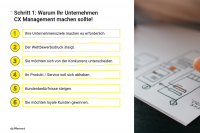
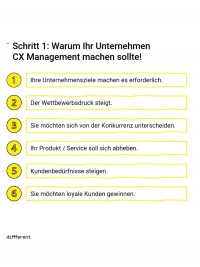
2: Where does your company stand right now?
Let's continue with the W-questions. If the "why" can be answered clearly, we move on to the "where": Where does your organization currently stand with regard to your CXM objectives? What is already going well, where is there still room for improvement? Only those who know where he or she stands can run in the right direction. Detours cost time and, above all, nerves. That is why it is important to reflect carefully at this point and evaluate the current situation.
3: Where do you want your company to evolve?
From actual to target: Now that you have found out where you are, the next step is to determine how to get to where you actually want to be. In order to stay on track in the future, you need a strategic framework and a clear vision of where you want to go with your CX strategy.
This plan can be well captured with the help of a CX mission statement. Such a customer experience mission statement is essential for determining the CX maturity, i.e. the actual position. The mission statement is also essential for the successful establishment of the strategy in the company. It contains the CX positioning (#1 Why) and the CX principles (#2 Where) and thus forms the overarching content bracket for the future design of the customer experience. This means that everyone from managers to interns is on board and knows exactly where the journey is headed.
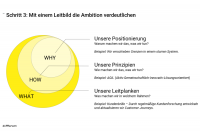
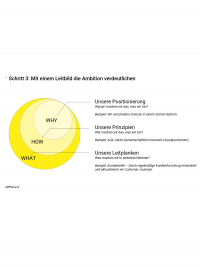
4: Where do we start as a company?
Enough planning, now it's time for implementation. The only question left is: Where do we start? After all, there are a lot of options for this, and you run the risk of quickly losing track of everything. In addition, resources are usually scarcer than what is planned. A clear and targeted focus is therefore particularly important. The CX map helps to identify all concrete projects in the form of proof points.
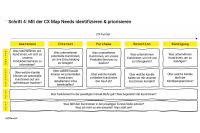

5: Who can help?
A lot of wo(man) power is needed to implement concrete projects to optimize the customer experience (proof points). Who can provide support outside of the core CX team? What skills might still be missing in the team? Customer experience management doesn't work in isolation. It's important to build a team that brings diverse skills, perspectives, and opinions. In order not to lose track of responsibilities - who is working on which proof point, who reports to whom, etc. - we recommend a stakeholder map.
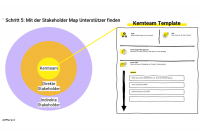
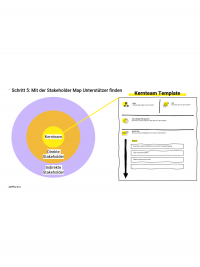
6: Want a Proof Point Booster?
CX mission statement? Done. CX map? Alive. Proof points? Identified. Team? Complete.
Basically, everyone is now ready to finally get started. Nevertheless, the first step is often still difficult. That's why we have our Proof Point Booster - it gives you the necessary support in case of doubt, so that you can reach your goal together as a team, step by step.
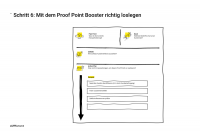
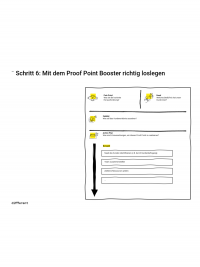
7: Is the mindset adapted by the whole company?
CX managers pave the way for more customer centricity, but the rest of the organization must also follow suit. All efforts are in vain if the customer-centric mindset is not established across the board. This requires signposts, because customer experience is a very abstract field for employees.
Interaction principles make CX tangible and are a helpful quality criterion for the realization of CX-oriented measures. Expressive titles such as AGIL (active-collaborative-innovative-solution-oriented) help to internalize the principles and to let them flow into daily work. In this way, CXM can be successfully anchored in all minds within the company.
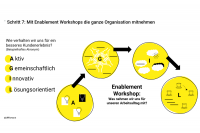
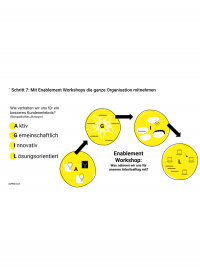
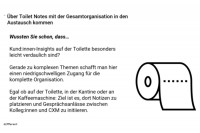
Toilet Notes are also a wonderful tool for making important customer insights tangible and easy to digest for the entire organization. Not only do they encourage you to put on your customers' glasses, but they also spark conversations between colleagues.
8: How do we as a company make CXM success measurable?
Well planned. Well implemented. Now it should also show up in the numbers. CX measures still suffer from high pressure to justify themselves, so don't forget to measure!
Establishing KPIs is not that easy. After all, CXM only orchestrates the customer experience - measurability depends on the concrete measures (proof points). Ideally, the relevant KPIs and metrics are therefore already considered during the planning of CX measures and recorded in the concept.
But note: CXM always pursues larger goals, such as holistic customer satisfaction and customer loyalty. However, it is not only CXM that pays off here, but the entire company. So there is no single KPI or metric to measure CX. Rather, the solution lies in a set of KPIs & metrics that must be evaluated according to the context and iterated regularly.

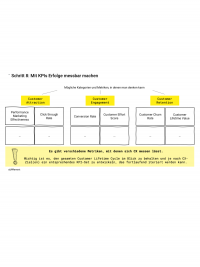
9: What happens after your company has achieved the first goals?
Consistent customer centricity is critical to success and is not a project that is ever completed. After the supposed final climb, it still continues and CX managers have to set many flags to bring everyone in the organization along. From our experience, we know that "we live customer centricity" is easier said than done. There is no one-size-fits-all solution for anchoring CX management centrally in the organization. On the contrary, it is as individual as the stumbling blocks that CXM encounters in the company:
Be it the lack of implementation power due to scarce resources on the part of IT, the lack of authority to delegate to project members, unclear KPIs for CXM, or insights that are not carried into the company.
In order for CXM to become part of the corporate DNA in the long term, it must continue to develop in a targeted manner. Thinking about how you want to organize CXM is the first step. We are happy to support you!
We are happy to receive project inquiries



